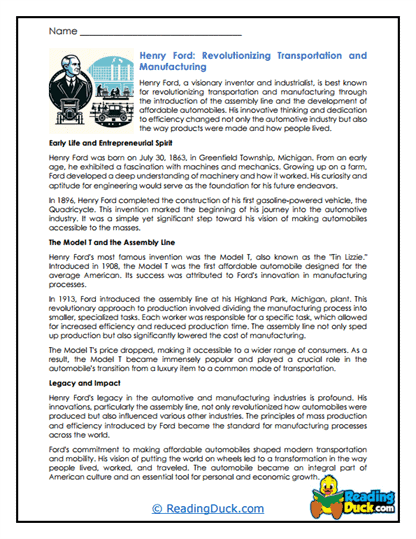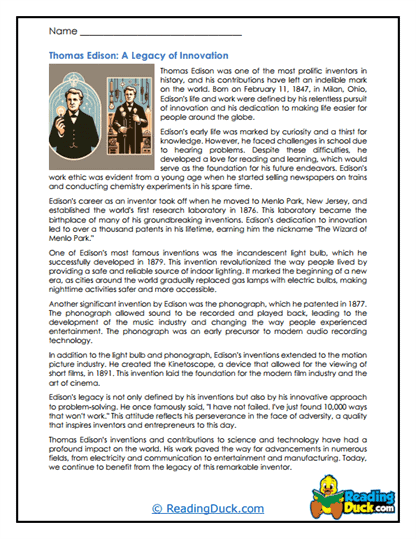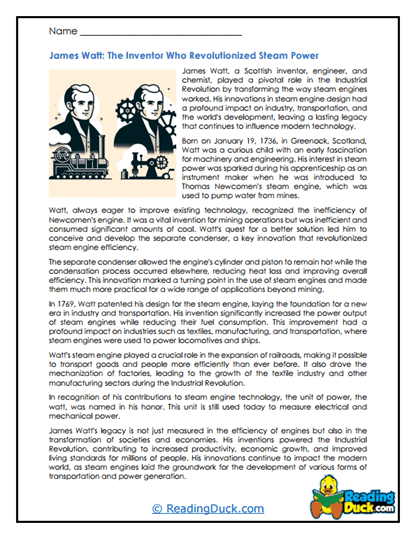Inventors Worksheets
About Our Inventors Worksheets
Our Inventors worksheets offer an engaging exploration into the lives and achievements of some of the most influential inventors in history. These worksheets are designed to inspire students by showcasing the creativity, perseverance, and impact of individuals who have transformed the world through their inventions. By studying the lives of these inventors, students can gain a deeper understanding of the innovation process and how groundbreaking ideas can shape society for generations.
Each topic in our Inventors collection contains several worksheet sets, each thoughtfully crafted to build students' understanding and connection to the material through a variety of activities. These sets include:
- Multiple Choice Questions: These questions assess students' comprehension of the reading passages, focusing on key facts about the inventor's life, career, and contributions to their field. This format helps reinforce students’ knowledge and encourages them to engage with the material in detail.
- Short Answer Questions: This format challenges students to reflect on what they’ve learned by writing their responses in their own words. These questions encourage deeper thinking and help students articulate their thoughts and insights about the inventor's influence and achievements.
- Open-Ended Questions: These questions invite students to explore their personal responses to the material, asking them to express opinions, preferences, or interpretations related to the inventor's experiences and legacy. This format fosters critical thinking and allows students to connect with the content on a more personal level.
Each worksheet set is designed to assess students’ understanding while enhancing their engagement with the topic. An answer key is provided for every question sheet, making it easy for educators to review and evaluate students’ progress. All worksheets are available as PDF files, which can be easily viewed electronically, downloaded, and printed.
Shaping the Future: The Legacy of History’s Greatest Inventors
Inventors are the driving force behind many of the technological advancements and conveniences that define our modern world. When introducing students to the world of inventors, it’s important to highlight how these individuals have not only solved problems but also opened new possibilities for human progress. By studying the lives and works of inventors, students can learn about the innovation process, the challenges inventors face, and the lasting impact their creations have on society.
Key Aspects of Inventors and Their Contributions:
- The Role of Inventors in Society: Inventors have been instrumental in shaping the world by introducing new technologies, tools, and methods that have improved lives and solved complex problems. Students should understand how inventors have contributed to various industries, from transportation and communication to medicine and energy. By learning about these contributions, students can appreciate the importance of creativity and innovation in driving societal progress.
- Influential Inventors Across Industries: The history of invention is filled with remarkable individuals who have made significant contributions across different fields. Figures like Thomas Edison in electricity, Marie Curie in radiation, and Nikola Tesla in electromagnetism have redefined what is possible and laid the groundwork for future advancements. Exploring the stories of these inventors helps students appreciate the diversity of innovation and the impact that these individuals have had on the world.
- The Innovation Process: Invention is not just about having a great idea; it involves a complex process of research, development, testing, and refinement. Students should explore how inventors navigate this process, often facing obstacles such as limited resources, skepticism, and failure. By understanding the innovation process, students can gain insights into the perseverance and problem-solving skills required to bring an invention to life.
- Cultural Impact and Legacy: Beyond their technical achievements, inventors have had a profound impact on culture and society. Their inventions have influenced everything from daily life and work to education and entertainment. For example, the invention of the printing press by Johannes Gutenberg revolutionized the spread of knowledge, while the Wright brothers' development of the airplane transformed global travel. Recognizing the cultural significance of inventors helps students see the broader impact of innovation on society and how it can shape the course of history.
- The Challenges of Invention: While inventors are often celebrated for their successes, they also face numerous challenges, including financial difficulties, patent disputes, and competition. Students should explore the obstacles that inventors encounter and how they overcome these challenges to achieve success. This perspective helps students develop a more nuanced understanding of the invention process and the resilience required to bring an idea to fruition.
By exploring these key aspects of inventors and their contributions to society, students can develop a well-rounded understanding of the innovation process and its significance. They will learn to appreciate the technical skills, creativity, and determination that inventors bring to their work. This knowledge not only enhances their education but also fosters a deeper connection to the stories of those who have shaped the modern world.
How to Effectively Use These Worksheets
To effectively incorporate our Inventors worksheets into your curriculum, here are some tips for teachers and parents:
- Thematic Lessons: Create themed lessons around specific industries, eras, or milestones in technological history. For example, explore the Industrial Revolution, focusing on how inventors like James Watt and Eli Whitney transformed manufacturing and industry.
- Comparative Analysis: Encourage students to compare and contrast the inventions and achievements of different inventors. This could involve examining the differences between inventors from different fields, or how various inventions have impacted society in unique ways.
- Interactive Discussions: Pair the worksheets with discussions about the ethical implications of invention and the responsibilities of inventors. This helps students critically evaluate the impact of inventions on society and consider the potential consequences of new technologies.
- Creative Projects: Assign creative projects where students can design their own inventions, create presentations on an inventor’s contributions, or write essays on the future of technology and innovation. These hands-on activities allow students to apply what they’ve learned in a practical and engaging way.
- Cross-Disciplinary Connections: Link the study of inventors with other subjects such as history, science, or social studies. For example, discuss the scientific principles behind an invention, or explore the historical context in which an invention was created and how it influenced society.
- Group Discussions: Use the open-ended questions in the worksheets as prompts for group discussions. Encourage students to share their thoughts on the contributions of inventors, the challenges they faced, and the impact of their work on society. These discussions can help students develop critical thinking skills and learn to articulate their opinions effectively.
- Assessment and Feedback: Use the multiple choice and short answer questions to assess students’ understanding of the material. Provide personalized feedback that highlights their strengths and areas for improvement, helping them grow as both students and future innovators.
By using these strategies, teachers and parents can help students gain a deeper understanding of the invention process, develop critical thinking skills, and foster a lifelong curiosity about innovation and technology. The Inventors worksheets are a valuable resource that can be integrated into a variety of educational settings, making the study of biographical details and the history of invention accessible and engaging for all students. Through consistent practice and exploration, students will not only learn about the great inventors of the past and present but also develop a greater appreciation for the role of creativity, perseverance, and innovation in shaping the future.









